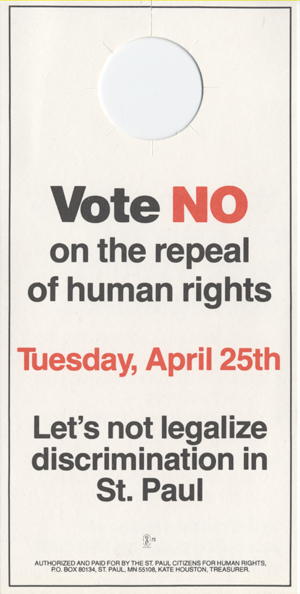St. Paul Citizens for Human Rights
P.O. Box 80134, St. Paul, MN (1978)
| A mother of four, Anita Bryant became involved with antigay politics when she read about a national child pornography ring in the Chicago Tribune.(1) Other newspapers reported similar cases and instigated a furor; the Los Angeles Times outrageously suggested that 30,000 children were being abused and “recruited” by L.A. homosexuals.(2) Bryant, her husband, and other Dade County residents used this mania to successfully convince voters to repeal gay rights in Miami in 1977.
|
 A Door Hanger from the 1978 Campaign. Courtesy of the Jean-Nickolaus Tretter Collection. |
In little over three months, SPCHR issued countless press releases, organized fundraisers, conducted door-to-door campaigns, and garnered supportive statements from the mayor and community leaders. The organization and its supporters went into April 25th with high expectations—they optimistically planned a celebratory party in The St. Paul Hotel—but their efforts ultimately proved unsuccessful. Voters repealed equal rights in St. Paul, and SPCHR only lasted long enough to repay its debt before disbanding in the fall of 1978.
(1)Zahasky, Kay. “Anita Bryant: Exclusive Interview” Today’s Student, 2/6/78. Front Page.
(2)The Los Angeles Times, 11/19/76.
(3)"St. Paul Citizens for Human Rights Collection." Tretter Collection in GLBT Studies: University of Minnesota Libraries.
Part of Minneapolis/St. Paul, MN: 100 Queer Places in Minnesota History, (1860-1969), (1969-2010)